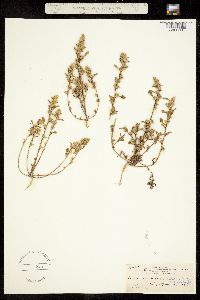

- Home
- Specimen Search
- Images
- Flora Projects
- Agency Floras
- Dynamic Floras
-
Additional Websites
- New Mexico Flores
- Plant Atlas Project of Arizona (PAPAZ)
- Southwest Colorado Wildflowers
- Vascular Plants of the Gila Wilderness
- Consortium of Midwest Herbaria
- Consortium of Southern Rocky Mountain Herbaria
- Intermountain Region Herbaria Network (IRHN)
- Mid-Atlantic Herbaria
- North American Network of Small Herbaria (NANSH)
- Northern Great Plains Herbaria
- Red de Herbarios del Noroeste de México (northern Mexico)
- SERNEC - Southeastern USA
- Texas Oklahoma Regional Consortium of Herbaria (TORCH)
- Resources
|
|
|
|
Family: Amaranthaceae
Sticky Amaranth
|
Plants densely viscid-pubescent (especially distal parts), becoming glabrescent proximally. Stems erect or ascending, often whitish or tinged with red, usually branched distally, sometimes proximally, to nearly simple, 0.2-1 m. Leaves: petiole usually longer than or ± equaling blade; blade rhombic-ovate, ovate, obovate, or elliptic, 1-4.5 × 0.5-2.5 cm, usually somewhat fleshy, base cuneate, margins entire, apex obtuse to slightly emarginate, with terminal mucro. Inflorescences terminal, usually unbranched, stout spikes and axillary clusters, erect, usually greenish or reddish, leafless at least distally. Bracts lanceolate to linear-lanceolate, 5-10 mm, longer than tepals, apex spinescent. Pistillate flowers: tepals 5, elongate, not clawed, unequal or subequal, 1.5-2.5 mm, apex obtuse to subacute; style branches elongated, shorter than body of fruit; stigmas 3. Staminate flowers few at tips of inflorescences; tepals 5; stamens 3-5. Utricles subglobose to broadly obovoid, 1.3-2.5 mm, equal or subequal to tepals, shorter than style branches, smooth or slightly rugose, dehiscence regularly circumscissile. Seeds black, lenticular to subglobose-lenticular, 1-1.2 mm diam., smooth, shiny. Flowering summer-fall. Open dry slopes, other naturally disturbed habitats; 1500-2500 m; N.Mex. Amaranthus viscidulus is known only from scattered localities in central and southern New Mexico; it probably also occurs in adjacent territories of Mexico. The name A. bracteosus Uline & W. L. Bray has been misapplied to this species by some authors.
|

Development supported by National Science Foundation Grants
(DBI 9983132,
BRC 0237418,
DBI 0743827,
DBI 0847966)
Powered by Symbiota
Powered by Symbiota



